Displaying items by tag: Former HAL sisters
Former Irish Serving Cruiseships Delivered to Scotland to Began New Career for UK Operator
Cruiseships Rotterdam along with Amsterdam both acquired from Holland America Lines to the ownership of Fred. Olsen Cruise Lines have together met up in Scotland following a delivery voyage from Cyprus, writes Jehan Ashmore.
The pair custom built for HAL will serve new careers with the UK operator which introduced the secondhand meidum sized cruiseships to become part of the newly revamped Fred. Olsen fleet. Each of the 61,000 gross tonnage ships of the same series have a capacity for 1,360 (standard occupancy) and crew od 615. Asides restuarants and bars, they have swimming pools, spa, gym, sports courts and a 'culinary' theatre.
The Amsterdam on Friday having sailed under the Forth and Queensferry bridges headed to Babcock's Rosyth facility, where already in the basin was berthed Rotterdam (previously reported for Covid-19 related incident).
The Amsterdam is to be renamed Bolette (as flagship) whereas Rotterdam is now Borealis whose Captain Jozo Glavic this week proudly raised the Fred Olsen houseflag on board, as part of the new ship’s official handover ceremony at the Scottish south-east port.
The cruiseships directly replace the ageing sisters Black Watch dating to 1972 and the one year younger Boudicca which over the years were callers to Dublin, Cork and Belfast.
Cruises for 2021/2022 are available now on both Bolette and Borealis for those scheduled to start from March 2021, but all of this remains subject to the uncertainty of Covid-19 and related travel restrictions.
Afloat has noted that Bolette starts a 7-nights 'Scenic Scotland' cruise on 5 March with an embarkation in Southampton. Also from the English Channel port is where Bolette is also to depart on 12 March on a 6-nights 'Cities of the UK & Ireland' cruise.





























































